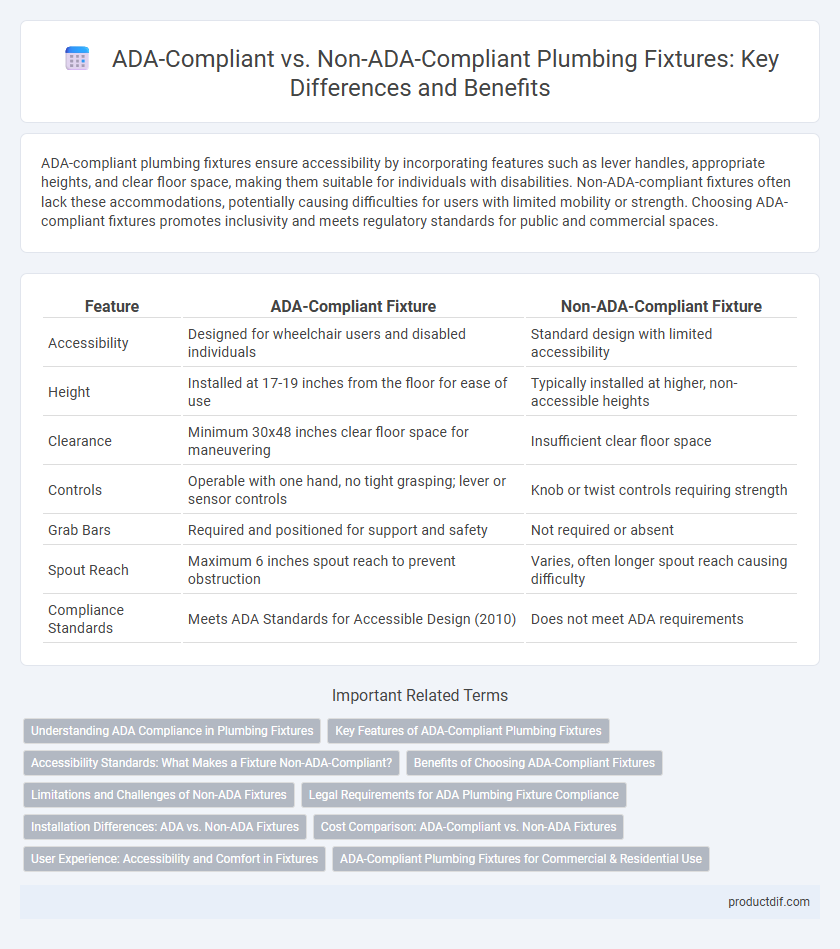ADA-compliant plumbing fixtures ensure accessibility by incorporating features such as lever handles, appropriate heights, and clear floor space, making them suitable for individuals with disabilities. Non-ADA-compliant fixtures often lack these accommodations, potentially causing difficulties for users with limited mobility or strength. Choosing ADA-compliant fixtures promotes inclusivity and meets regulatory standards for public and commercial spaces.
Table of Comparison
| Feature | ADA-Compliant Fixture | Non-ADA-Compliant Fixture |
|---|---|---|
| Accessibility | Designed for wheelchair users and disabled individuals | Standard design with limited accessibility |
| Height | Installed at 17-19 inches from the floor for ease of use | Typically installed at higher, non-accessible heights |
| Clearance | Minimum 30x48 inches clear floor space for maneuvering | Insufficient clear floor space |
| Controls | Operable with one hand, no tight grasping; lever or sensor controls | Knob or twist controls requiring strength |
| Grab Bars | Required and positioned for support and safety | Not required or absent |
| Spout Reach | Maximum 6 inches spout reach to prevent obstruction | Varies, often longer spout reach causing difficulty |
| Compliance Standards | Meets ADA Standards for Accessible Design (2010) | Does not meet ADA requirements |
Understanding ADA Compliance in Plumbing Fixtures
ADA-compliant plumbing fixtures meet strict guidelines set by the Americans with Disabilities Act, ensuring accessibility, usability, and safety for individuals with disabilities. These fixtures feature specific height, clearance, and operability requirements, such as lever handles and adequate knee space, distinguishing them from non-ADA-compliant fixtures. Non-ADA-compliant fixtures often lack these adaptations, limiting access for people with mobility impairments and failing to meet legal standards for public and commercial buildings.
Key Features of ADA-Compliant Plumbing Fixtures
ADA-compliant plumbing fixtures are designed with key features such as accessible height, clear floor space for wheelchair maneuverability, and operable parts that require minimal force or dexterity, ensuring usability for individuals with disabilities. These fixtures include specific dimensions, like faucets with lever handles positioned no higher than 48 inches and sink edges that allow knee clearance of at least 27 inches. Non-ADA-compliant fixtures often lack these specifications, making them less accessible and more difficult to use for people with mobility or strength limitations.
Accessibility Standards: What Makes a Fixture Non-ADA-Compliant?
A non-ADA-compliant plumbing fixture fails to meet accessibility standards by lacking proper clearances, height requirements, or operable parts usable with limited hand dexterity. Dimensions such as reach ranges beyond 48 inches or controls requiring tight grasping and twisting contribute to non-compliance. Fixtures that do not provide adequate knee clearance, lavatory space, or lever-operated handles hinder accessibility for individuals with disabilities.
Benefits of Choosing ADA-Compliant Fixtures
ADA-compliant plumbing fixtures provide enhanced accessibility and usability for individuals with disabilities, ensuring adherence to the Americans with Disabilities Act standards. These fixtures feature design elements such as appropriate height, lever-style handles, and sufficient clearance, which improve convenience and safety for all users. Choosing ADA-compliant fixtures also promotes inclusivity and can help businesses avoid legal liabilities related to accessibility noncompliance.
Limitations and Challenges of Non-ADA Fixtures
Non-ADA-compliant plumbing fixtures often present significant accessibility barriers for individuals with disabilities, including insufficient clear floor space and inappropriate heights that hinder wheelchair use. These fixtures may lack essential features such as lever handles or touchless controls, complicating operation for users with limited dexterity or strength. Non-compliance can also lead to legal challenges and costly retrofits to meet ADA standards, impacting overall facility inclusivity and functionality.
Legal Requirements for ADA Plumbing Fixture Compliance
ADA-compliant plumbing fixtures must meet strict legal requirements including specific height, clearance, and operability standards to ensure accessibility for individuals with disabilities, as mandated by the Americans with Disabilities Act (ADA). Non-ADA-compliant fixtures often fail to provide the necessary knee and toe clearance, appropriate lever handles, and proper installation heights, resulting in violations that can lead to costly fines and required retrofits. Compliance with these legal standards is essential for public buildings, commercial properties, and facilities to avoid legal liabilities and ensure inclusive access.
Installation Differences: ADA vs. Non-ADA Fixtures
ADA-compliant plumbing fixtures require specific installation guidelines to meet accessibility standards, including precise mounting heights and clear floor space to accommodate wheelchairs. Non-ADA fixtures often lack these specifications, leading to more flexible but less accessible placement options. Proper installation of ADA fixtures ensures usability and legal compliance, which differs significantly from the less regulated installation of non-ADA fixtures.
Cost Comparison: ADA-Compliant vs. Non-ADA Fixtures
ADA-compliant plumbing fixtures typically cost 20-30% more than non-ADA-compliant options due to specialized design features such as accessible height, lever handles, and clear floor space requirements. While initial expenses are higher, ADA fixtures reduce liability risks and ensure compliance with the Americans with Disabilities Act, potentially avoiding costly fines. Non-ADA fixtures may present lower upfront costs but can result in expensive retrofitting or legal penalties when accessibility standards are enforced.
User Experience: Accessibility and Comfort in Fixtures
ADA-compliant plumbing fixtures enhance user experience by providing accessible heights, clear floor space, and easy-to-operate controls, ensuring comfort for individuals with diverse mobility needs. Non-ADA-compliant fixtures often lack these features, creating barriers such as difficult reach and inadequate maneuvering space that reduce accessibility and comfort. Prioritizing ADA standards in fixture design significantly improves usability for all users, especially those with disabilities.
ADA-Compliant Plumbing Fixtures for Commercial & Residential Use
ADA-compliant plumbing fixtures ensure accessibility by meeting the standards set by the Americans with Disabilities Act, including features such as proper height, clear floor space, and ease of operation for individuals with disabilities. These fixtures are designed for both commercial and residential use, promoting inclusivity and safety while maintaining functionality and aesthetic appeal. Non-ADA-compliant fixtures often lack these critical design elements, potentially limiting accessibility and failing to meet legal requirements in public and multi-family residential settings.
ADA-compliant fixture vs Non-ADA-compliant fixture Infographic

 productdif.com
productdif.com